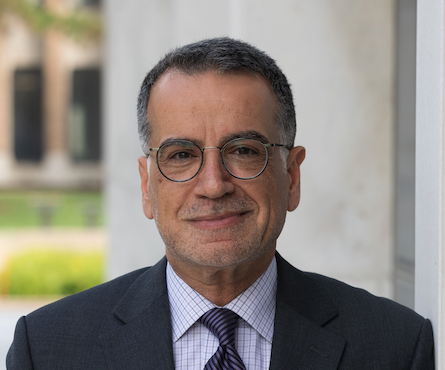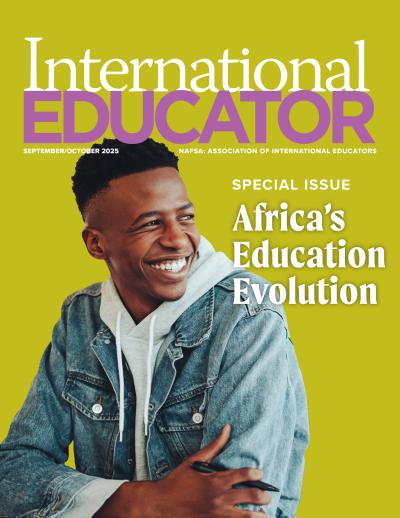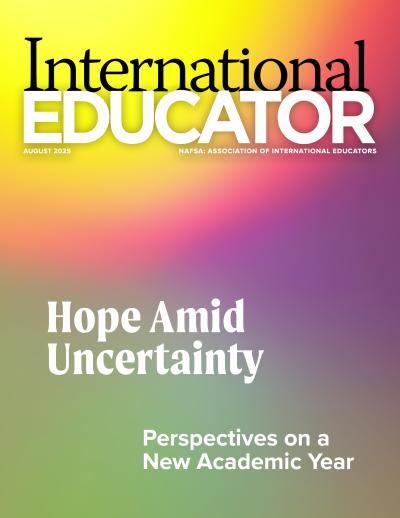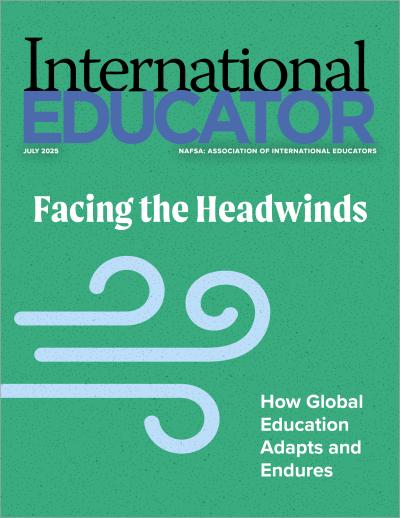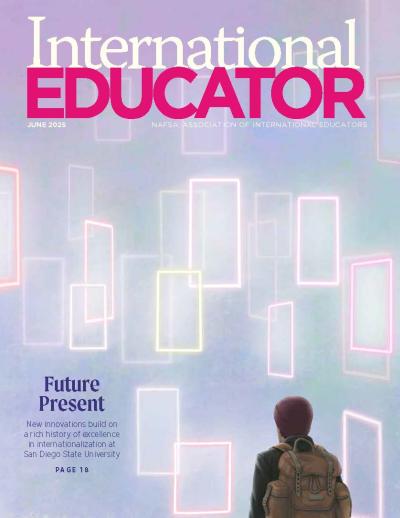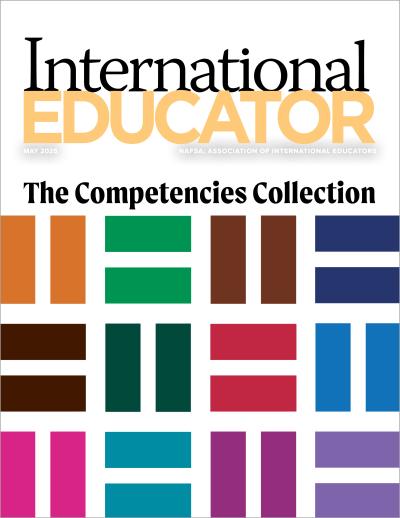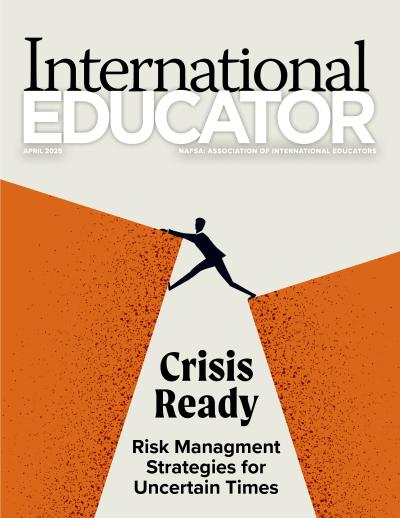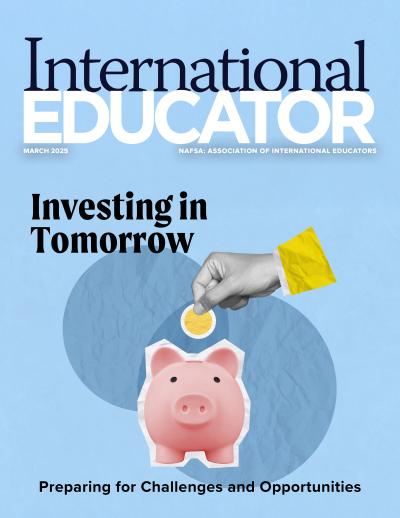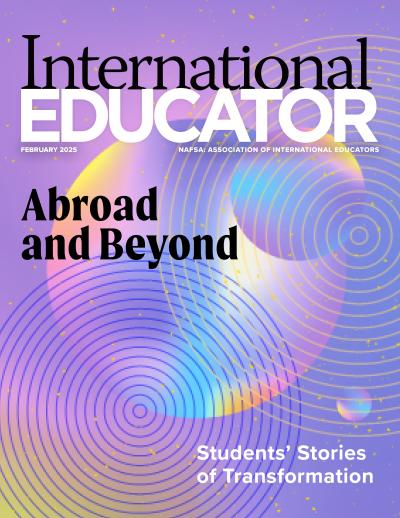Ahmad Ezzeddine: Supporting the Mission

Ahmad Ezzeddine’s deep commitment to global engagement has made him a driving force in the field of international education. Ezzeddine, who came to the United States from Lebanon as an international student, has spent almost all of his academic and professional careers at Wayne State University in Detroit, Michigan. But 2025 is bringing many changes: This month, he transitions into a new role at the University of Washington and takes the helm of NAFSA’s Board of Directors as president.
Ezzeddine is poised to lead at a time of significant change and opportunity in the field. In this interview, he reflects on his journey in international education, including how his career began, his long-standing involvement with NAFSA, and the lessons he’s learned through his work on the NAFSA board. With a focus on the intersection of international education, economic development, and community engagement, Ezzeddine shares his perspective on the opportunities and challenges facing the field today. He also discusses his vision for NAFSA’s role in navigating these evolving dynamics and the impact of the board’s actions on the broader international education community.
Editor’s note: This interview has been condensed and edited for clarity.
You are beginning two new roles this year: president of the NAFSA Board of Directors and the new vice provost for global affairs at the University of Washington. How are you feeling at the start of a big year of change for you professionally?
I am very excited about the change and that it’s happening at the beginning of the year. My birthday was also earlier this month, so it feels like a renewal. Change has always been something I welcome and view as an opportunity to refresh my perspective, learn new things, meet new people. And in both of these roles, I will have these opportunities. There’s a little bit of anxiety, of course, especially with the move from Detroit to Seattle. That’s a major transition. It reminds me of when I moved from Lebanon to the United States as a student. After a short stay in Utah, I moved to Michigan, where I have lived ever since. This has been home, and now I’m relocating to another part of the country. I am excited about being in Seattle and Washington state, and I’m thrilled about my work and new role at the University of Washington.
This position allows me to continue to pursue my passion for global education, which has been a consistent focus throughout my career. I am excited about the opportunity to concentrate specifically on this area in my new role. This also aligns with my new role at NAFSA, where I’m honored to succeed LaNitra Berger, who’s been an exceptional leader and president. She set a high standard for me to follow.
Tell us a little bit about yourself for those who don’t know you. How did you get started in international education? When did you become involved with NAFSA, and how did that begin?
The start of my career in international education in some ways began as an international student. I came to the United States in 1988 from Lebanon. I transferred from the American University of Beirut first to the University of Utah, and then I found my way to Detroit to Wayne State University, where I’ve been since. After getting my MBA in the early 1990s, I started working with a very energetic, visionary, and entrepreneurial leader, who was engaged with the development work in Eastern Europe after the fall of the Berlin Wall and all the countries in that region started to open up to the [rest of the] world. Our first project was working with Ukraine back in ‘91, ‘92, which was my introduction to the professional world of international education. We started to host scholars and professionals from various Eastern European countries, providing technical assistance, conducting workshops, and supporting program development. I assumed the role of senior international officer (SIO) at Wayne State University in 2007, a position I held until recently.
From the outside, you don’t understand the board’s and organization’s workings. So, joining the board was fascinating for two reasons.
When I became SIO, I started attending the NAFSA annual conference. That’s what you do if you’re in international education; you go to NAFSA! I was invited to interview for and joined the board in 2018. Two years after that, I was elected vice president for scholarship and institutional strategy.
From the outside, you don’t understand the board’s and organization’s workings. So, joining the board was fascinating for two reasons: First, the expertise, effort, and skill required to run an organization like NAFSA and serve its large membership is impressive. Second, the contributions of all the board members are remarkable. The NAFSA board covers all aspects of international education—universities, third-party providers, agents, government agencies, etc. It represents the membership, serving as their voice and supporting their interests and needs. It speaks to the world of international education, which crosses geographical, professional, and cultural boundaries. We’re all interconnected, each bringing unique expertise and experiences that support and advance our collective mission.
As you mentioned, you have been on the NAFSA board for several years, most recently as vice president (VP) of scholarship and international institutional strategy. You talked a little bit about what that experience was like, but is there anything that you’ve learned since you’ve been serving on the board that will inform your approach to your role as president?
One of the most exciting aspects that rises to the top of being involved in the scholarship and institutional strategy committee is that the VP is involved in planning the annual conference. You get to appreciate the significant amount of work and effort that goes into organizing this event. It’s remarkable to observe where we start and how we end. The process highlights the power and value that members bring not only through their contributions to session proposals but also through the efforts of volunteer leaders and staff on the Annual Conference Committee (ACC) who organize and put the conference together. It’s like conducting a symphony with all the different instruments, culminating in an impressive presentation at the end of May every year. And despite occasional turbulence, as volunteer members make adjustments on the go and manage their regular duties and day jobs, the result is an expertly organized conference for 8,000–10,000 attendees annually. This event brings together thought leadership in international education and provides professional development opportunities for all members. Witnessing this process has been extremely rewarding, fulfilling, and an excellent learning experience for me.
The process highlights the power and value that members bring not only through their contributions to session proposals but also through the efforts of volunteer leaders and staff on the Annual Conference Committee (ACC) who organize and put the conference together. It’s like conducting a symphony with all the different instruments, culminating in an impressive presentation at the end of May every year.
Another highlight for me is getting to work more closely with the volunteers on the ACC, as well as the board members on the scholarship and institution strategy committee. The committee structure allows the vice president to develop closer relationships with board members and gain insights from their expertise, which may not be fully explored during the large full board meetings. Lastly, an initiative I have advocated for as VP focuses on improving engagement with our global and non-U.S.-based members. This is an area that we are starting to emphasize and will continue to prioritize in the coming years.
What are you most looking forward to in this new role on the board?
I’m looking forward to working with NAFSA Executive Director and CEO Fanta Aw and the exceptional staff at NAFSA. I talked about the contributions of board members, but I also want to acknowledge the efforts of the dedicated NAFSA staff, who run the organization like a seamless engine. They do the heavy lifting and facilitate our jobs as board members. I’m also excited about continuing my learning journey and getting to know the new members who are joining the board this year.
Additionally, we have to collectively examine how we can continue NAFSA’s foundational work. How do we best support our members? How do we foster their professional development and continue to advocate for the importance of international education? There are many developments that will impact the field, both positively and negatively. We must be prepared to address these challenges and proactively work on them. How do we maintain NAFSA’s position as a leading authority for international education not only in the United States but also in the world? How do we continue to collaborate with our partner and sister organizations to continue to advance these goals?
How do the board’s actions directly affect NAFSA members and their work?
The board’s actions have a direct and significant impact on NAFSA members and their work. One of the main insights I gained when I joined the board is a glimpse into the financial structures of the organization. As members, we sometime discuss the expense of NAFSA membership and the annual conference. But we also know that NAFSA provides unparalleled professional development, resources, and support for international education advisers and professionals. So, as a board, our primary responsibility is to ensure that NAFSA remains a valuable resource for our members and continues to serve them effectively. This involves providing oversight, serving as fiduciary agents, and making sure that sound financial decisions to support the organization’s work and goals are being made. The board is also responsible for steering NAFSA’s future direction. We will be updating the strategic plan in the coming year to ensure we remain current and relevant and can adapt to the evolving landscape of international education.
As a board, our primary responsibility is to ensure that NAFSA remains a valuable resource for our members and continues to serve them effectively.
Yes, the world and our field are both changing! What do you think are some of the biggest opportunities in general for international education right now? What are some of the biggest challenges?
I am the eternal optimist. I see many opportunities. Current events highlight the importance of international education and the importance of collaboration between institutions, people, and countries. There are great innovations and advances in technology that enhance and facilitate the opportunities to pursue international education and engage in global learning. A few years ago, Zoom and virtual meetings were not a common practice. Now, they have become an integral part of daily life. Many institutions are implementing Collaborative Online International Learning (COIL), enabling students to gain international exposure without leaving their campuses. We can’t forget the economic growth and contributions that result from international education. NAFSA has a tool that tracks the economic impact of international students on local communities in the United States, which is significant, not to mention contributions that international graduates add to the workforce.
I am the eternal optimist. I see many opportunities.
Two of the challenges are equity and access to global experiences, which remain significant issues for us to address. Technology could help alleviate some of these issues, as we discussed, but they are hard to overcome. Also, currently, regulations and policies that impact our work—not just in the United States but worldwide—are a challenge. While some regulations may seem minor, they can significantly affect or hinder access to international education. For instance, the requirement to register for a study abroad program beforehand creates a bottleneck that may deter participation or make it not feasible. Additionally, obtaining visas has been a persistent issue. Geopolitical conflicts worldwide also present considerable challenges. We at NAFSA, along with our partner and sister organizations, must continue to advocate and emphasize the importance of our work and work on ensuring that regulations and policies consider these factors.
Where do you see NAFSA’s leadership in the field come into play with these opportunities and challenges?
I think NAFSA is certainly one of the foremost organizations that must advance this work. Being one of the largest organizations in our field and having the most diverse membership in terms of professionals from various levels and countries, our reach is broader and likely larger than many other sister organizations that take on this work. This position imposes a responsibility on us to lead some of these efforts—not independently but in collaboration with others to ensure this work continues. We must advocate, establish the importance of this field, and contribute to its development.
It is imperative that we continue to strengthen and demonstrate the integral role of international education in various professional domains.
But one significant challenge we face is maintaining the growth of the field, particularly during times of crisis. Historically, crises affecting international education have often led to a contraction in and exodus from the field—and not always by choice. It is imperative that we continue to strengthen and demonstrate the integral role of international education in various professional domains. In higher education, for instance, whether one is a counselor, adviser, or faculty member, considerations of international education should be embedded in one's work. As NAFSA, we must continue to invest in developing the field and the profession by providing and expanding necessary resources for professionals and promoting the career opportunities and paths that exist, particularly for young professionals.
Over your career you’ve had a focus on the intersection of international education and economic and community development. What has most informed your work in this area? Why do you think it’s important to explore that intersection?
I do not believe they should be separated. International education is indeed a distinct discipline and field; however, it must be integrated into all aspects of our activities. Business majors, for instance, require global experiences, as no modern company or organization operates without international involvement, especially with today’s technology. Preparing students in Detroit for today’s world of work involves equipping them to engage with global counterparts. Many of our students will be employed by companies such as General Motors or Ford, where they may find themselves in meetings with colleagues from Brazil, Shanghai, or Mexico during their first week on the job.
International education cannot be isolated from economic and community development, just as health care, supply chain, and global health are interconnected, as evidenced during the COVID-19 pandemic. Events in one part of the world have repercussions globally.
Furthermore, international education provides significant value to local communities. As we discussed earlier, the positive impact of international students on local communities is well researched and documented. Beyond their economic contributions, they enrich communities by sharing their culture, language, food, and art. This cultural exchange enhances communities, making them more vibrant and diverse. The interplay between these elements underscores the importance and beauty of international education. •
About International Educator
International Educator is NAFSA’s flagship publication and has been published continually since 1990. As a record of the association and the field of international education, IE includes articles on a variety of topics, trends, and issues facing NAFSA members and their work.
From in-depth features to interviews with thought leaders and columns tailored to NAFSA’s knowledge communities, IE provides must-read context and analysis to those working around the globe to advance international education and exchange.
About NAFSA
NAFSA: Association of International Educators is the world's largest nonprofit association dedicated to international education and exchange. NAFSA serves the needs of more than 10,000 members and international educators worldwide at more than 3,500 institutions, in over 150 countries.
NAFSA membership provides you with unmatched access to best-in-class programs, critical updates, and resources to professionalize your practice. Members gain unrivaled opportunities to partner with experienced international education leaders.


